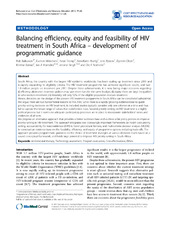| dc.contributor.author | Baltussen, Rob | en_US |
| dc.contributor.author | Mikkelsen, Evelinn | en_US |
| dc.contributor.author | Tromp, Noor | en_US |
| dc.contributor.author | Hurtig, Anne Karin | en_US |
| dc.contributor.author | Byskov, Jens | en_US |
| dc.contributor.author | Olsen, Øystein Evjen | en_US |
| dc.contributor.author | Bærøe, Kristine | en_US |
| dc.contributor.author | Hontelez, Jan A. | en_US |
| dc.contributor.author | Singh, Jerome | en_US |
| dc.contributor.author | Norheim, Ole Frithjof | en_US |
| dc.date.accessioned | 2013-11-20T09:01:47Z | |
| dc.date.available | 2013-11-20T09:01:47Z | |
| dc.date.issued | 2013-10-09 | eng |
| dc.Published | Cost Effectiveness and Resource Allocation11(1):26 | eng |
| dc.identifier.issn | 1478-7547 | |
| dc.identifier.uri | https://hdl.handle.net/1956/7545 | |
| dc.description.abstract | South Africa, the country with the largest HIV epidemic worldwide, has been scaling up treatment since 2003 and is rapidly expanding its eligibility criteria. The HIV treatment programme has achieved significant results, and had 1.8 million people on treatment per 2011. Despite these achievements, it is now facing major concerns regarding (i) efficiency: alternative treatment policies may save more lives for the same budget; (ii) equity: there are large inequalities in who receives treatment; (iii) feasibility: still only 52% of the eligible population receives treatment. Hence, decisions on the design of the present HIV treatment programme in South Africa can be considered suboptimal. We argue there are two fundamental reasons to this. First, while there is a rapidly growing evidence-base to guide priority setting decisions on HIV treatment, its included studies typically consider only one criterion at a time and thus fail to capture the broad range of values that stakeholders have. Second, priority setting on HIV treatment is a highly political process but it seems no adequate participatory processes are in place to incorporate stakeholders’ views and evidences of all sorts. We propose an alternative approach that provides a better evidence base and outlines a fair policy process to improve priority setting in HIV treatment. The approach integrates two increasingly important frameworks on health care priority setting: accountability for reasonableness (A4R) to foster procedural fairness, and multi-criteria decision analysis (MCDA) to construct an evidence-base on the feasibility, efficiency, and equity of programme options including trade-offs. The approach provides programmatic guidance on the choice of treatment strategies at various decisions levels based on a sound conceptual framework, and holds large potential to improve HIV priority setting in South Africa. | en_US |
| dc.language.iso | eng | eng |
| dc.publisher | BioMed Central Ltd. | eng |
| dc.rights | Attribution CC BY | eng |
| dc.rights.uri | http://creativecommons.org/licenses/by/2.0 | eng |
| dc.subject | Antiretroviral therapy | eng |
| dc.subject | Technology assessment | eng |
| dc.subject | Program evaluation | eng |
| dc.subject | Cost-effectiveness | eng |
| dc.subject | Ethics | eng |
| dc.title | Balancing efficiency, equity and feasibility of HIV treatment in South Africa - development of programmatic guidance | en_US |
| dc.type | Peer reviewed | |
| dc.type | Journal article | |
| dc.date.updated | 2013-10-10T23:08:07Z | |
| dc.description.version | publishedVersion | en_US |
| dc.rights.holder | Copyright 2013 Baltussen et al.; licensee BioMed Central Ltd. | |
| dc.rights.holder | Rob Baltussen et al.; licensee BioMed Central Ltd. | |
| dc.identifier.doi | https://doi.org/10.1186/1478-7547-11-26 | |
| dc.identifier.cristin | 1113296 | |

